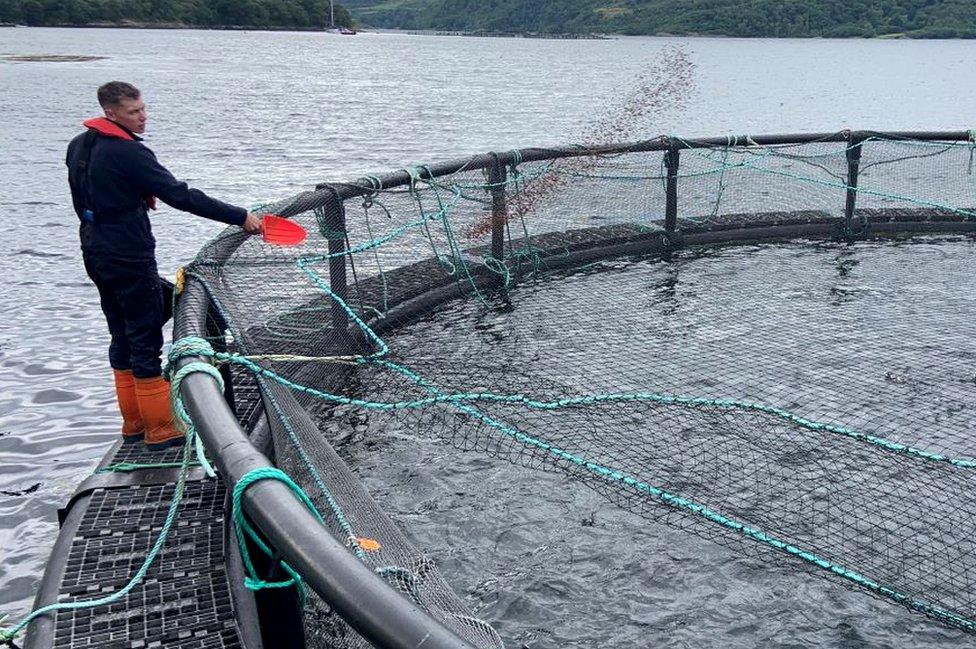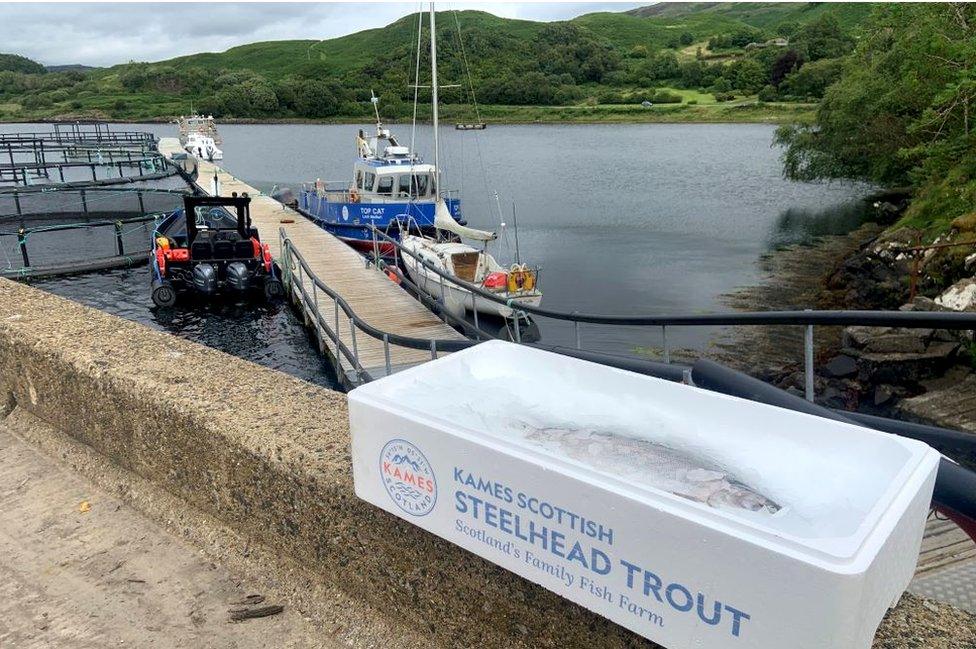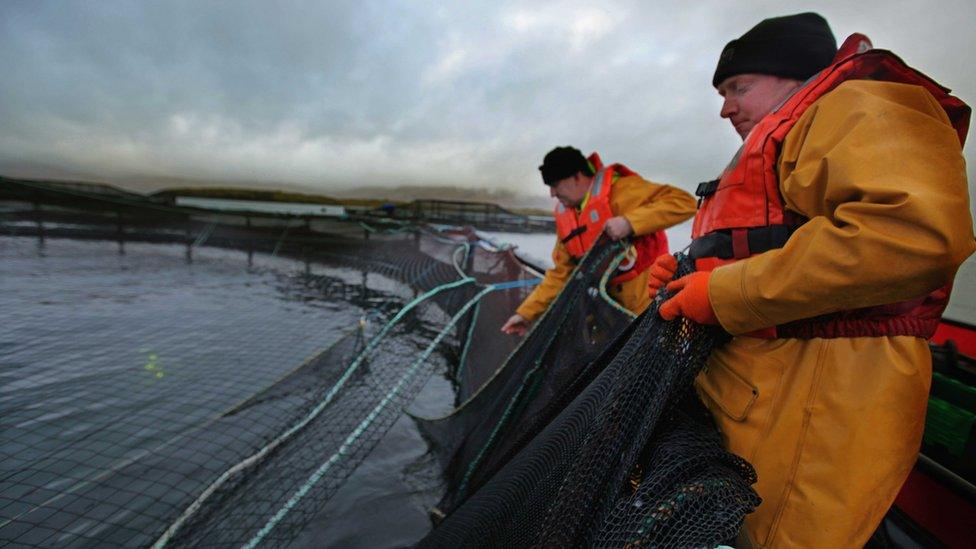New strategy seeks to calm waters around fish farming in Scotland
- Published

Rural Affairs Secretary Mairi Gougeon spoke to Andrew Cannon on a visit to Kames Fish Farming
Ministers say they want to improve relations surrounding the fish farming industry as the Scottish government publishes a new vision for the sector.
Last year a report said there was "mistrust, dislike and vitriol" between the industry, its regulators, the government and campaigners.
Rural Affairs Secretary Mairi Gougeon said it was something she aimed to fix.
The vision puts new responsibilities on the industry to work with its critics to improve marine habitats.
There will also be moves to streamline the planning process and improve infrastructure for the industry.
Professor Russel Griggs, the author of the independent report, said that some in the salmon farming sector had told him there were Scottish government agencies, though unnamed, that were acting to close down the aquaculture industry.
This year, the industry and its critics have clashed over plans to create Highly Protected Marine Areas (HPMA), which were seen as being likely to force closure for some fish farms.
The plans were recently shelved by the Scottish government in the face of criticism, and new ones are being drawn up.

In May, SalMar, one of the large Norwegian companies which jointly owns Scottish Sea Farms, said criticism of the industry was making Scotland a particularly difficult country in which to grow the industry.
Ms Gougeon, the cabinet secretary for rural affairs, land reform and islands, said it was important to listen to the feedback which had been received to the HPMA plans.
"I don't think there's any getting round the fact that we need to enhance and improve our marine environment and biodiversity," she said.
"What's important now is how you move forward, how we engage communities and industry in that work."
Ms Gougeon has published the Vision for Sustainable Aquaculture with a call for the industry and its critics to work together.
She said she was "really concerned and frustrated" to learn of the conflict.

"It's an area we want to fix, to improve the relations," she said.
"We've already started a programme of work - I set up the Scottish Aquaculture Council, which has representatives from different regulators and the industry as well as environmental organisations, to talk through the recommendations that came from Russel Griggs' review.
"We know there are differences of opinion, but it's only by having that engagement, by being transparent and setting out the vision, as we're doing, that everyone will be in a place where we can coalesce around that, and move forward."
The vision seeks to balance the industry's demand to have an efficient and transparent process for securing consent for developments.
That has been hampered by rules that require four different Scottish government agencies to consult with each other on industry application.
A streamlined process, including Marine Scotland, Crown Estate Scotland and the Scottish Environment Protection Agency, is to be trialled this year.

The vision also gives the industry support for improved infrastructure, including rural broadband and housing for its workers in coastal communities where the options are constrained and expensive.
The industry is being told, however, that it will have to contribute its expertise and resources to restoring and improving the marine environment and biodiversity.
The principles set out in the vision statement say that the polluter should pay for damage done, and that it should seek to prevent damage rather than clearing up afterwards.
"Spatial" planning will take account of the layers of pressure on sea lochs, and the "cumulative impact" of the industry over time will be taken into account. Both those elements of the vision have been welcomed by campaigners for cleaner seas.

Scottish aquaculture in numbers
Scottish government figures showed that in 2021 there were 351 finfish farms - which produced 205,400 tonnes of salmon and 7,655 tonnes of rainbow trout - and 167 shellfish farms.
In 2022, the harvest included 11,600 tonnes of mussels, 117,000 native oysters, 7.5m Pacific oysters and 39,500 scallops.
In 2018, the aquaculture industry was estimated to support 11,700 jobs. Of the £1.4bn spent on supplies and investments, 76% was spent in Scotland.

The industry is being expected to reduce its carbon emissions, including changes to fish feed and less use of single-use polystyrene packaging, which is extensively used for air freight of exported salmon.
A heavy emphasis is being placed on innovation by the industry to find ways to mitigate harm; expand the range of products, including shellfish and seaweed; and to look at ways it can farm different products in the same sea areas.
Ms Gougeon said there should be "a number of outcomes" to help reach a sustainable future for aquaculture between now and 2045.
"We know that our fish health and welfare is vitally important," she said.
"We know there's a lot of work to be done for the sector to reach net zero ambitions. The sector is doing a lot a lot of work in that regard already. but we also know we need to enhance our marine biodiversity."

Cate Cannon of Kames Fish Farming said there were misconceptions about the industry
The cabinet secretary added the vision will put coastal communities at the heart of developments happening nearby, to ensure that they also "reap the benefits of these developments".
Earlier this week, the minister visited Kames Fish Farming at Lochmelford in Argyll. It is a family firm, set up more than 50 years ago, which only farms steelhead trout, producing around 2,500 tonnes per year.
The company's Cate Cannon said there were misconceptions about the industry that it needed to address.
"The majority of farms work very closely with their local communities and their local environment," she said.
"It's in our interest to have good water quality. You could almost say we're lighthouses or guardians of the ocean. We're looking at the temp and salinity every day, and we should be able to share that information.
"Sometimes, it feels like we're not working in partnership enough - it's us and them. I hope the discourse is starting to shift so that we can innovate and collaborate and work towards a more sustainable future, which is what everyone wants."
She added that support for innovation should not only support big firms with research budgets.

Clare Cavers said it was important that the commitments were delivered
Clare Cavers, senior project manager at Fidra, which campaigns on seawater quality, said it was very supportive of the five guiding principles outlined in the government's vision statement.
These are integrating environmental protection into policy-making; using the precautionary principle; taking action to prevent environmental damage; prioritising rectifying it at source where it does occur; and the principle that the polluter pays.
"We are also pleased to see the spatial planning commitment and inclusion of assessment of cumulative risk," she said.
"It is now key to ensure the implementation of the vision is carried out in a measurable and timely way, and the commitments are delivered."
Tavish Scott, chief executive of Salmon Scotland, said the vision put salmon farming at the heart of the country's economic growth plans.
"The blue economy has the potential to both increase food security at home and feed the growing global population," he said.
"Scotland is uniquely placed to lead the way in the drive for the sustainable use of the oceans and seas, while conserving our shared environment for future generations."
Related topics
- Published11 February 2022
- Published1 June 2023